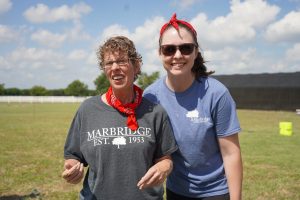By Kim Hilsenbeck
Low lights, soft music, massage and bubbles. These are just some of the features of the new Sensory Room at Marbridge Villa, a long-term care facility, at Marbridge in Manchaca.
Alicia Taylor, a licensed Clinical Social Worker, is the social services director at Marbridge Villa. She along with Life Services Specialists Teresa Nutt and Jameson Miller provided a tour of the room, also called a sensorium, which is part of the facility’s Life Enrichment Center. Built in February with funds from a private anonymous donation, the sensorium is part of the occupational and speech therapy for many patients at the Villa.
“It was designed for stimulation for people with more severe disabilities,” Taylor said.
She said Marbridge Villa specializes in individuals with intellectual and developmental disabilities including autism, cerebral palsy, organic brain damage.
“It is for people who need more care than assisted living can provide,” Taylor said. The Villa currently is home to about 90 residents.
Walking into the room from the brightly lit hallway is like stepping into another world. Twinkling lights, bubbles inside liquid filled columns and images projected onto the wall create a serene, calming space. Soft music piped in invites visitors to experience a quiet moment. A massage pad on an oversized chair sits in one corner, a zero gravity chair in another.
On a table, various items including a fur stole, a box with drawers and a board with various knobs and switches provide a tactile workshop.
Strands of LED lights hanging near the door offer a visual and tactile experience.
“They can touch them and braid them,” Taylor said.
She said one resident who is legally blind and very severely disabled saw and reached out for the lights.
“I’ve never seen her reach out for anything and I’ve been here six years,” Taylor said.
Several bubble columns throughout the room offer different experiences. One provides visual calming or stimulation, depending on the speed of bubbles rising, which is adjustable.
“Bubbles floating up slowly is calming, but we can speed them up to stimulate or wake up a patient,” Taylor said.
Another bubble column changes colors when buttons are pushed. A third uses voice activation to change colors.
“You can turn down the sensitivity so they have to speak louder to get the bubble column to change colors,” Taylor explained.
Resident Anne Marie Mills, or “Annie” as most staff call her, has lived at Marbridge Villa for about seven years. Diagnosed at a young age with cerebral palsy and epilepsy, she is considered severely disabled, with limited mobility. Annie, 27, is also non-verbal for the most part.
When staff brought her into the sensorium last week, they noticed she seemed more alert and aware of her surroundings.
Miller placed Annie on the massage chair, which he said is used to help stimulate her nerve endings and help her feel sensations. Her eyes followed the images projected on the wall, which Miller said are also used for persons with Alzheimer’s and other forms of dementia.
Annie’s mom, Cindy Mills, spoke about her daughter – called “Ree” by her three siblings – and her connection with sensory experiences.
“We noticed as Annie was growing up that anything that she could touch we noticed a facial reaction to it, whether she liked it or not, like a potato chip bag; we would squeeze the bag – she would react, start to laugh and want more,” Mills said. “We bought a lot of potato chips.”
Mills said Annie also liked to press big red buttons that were connected, for example, to a fan, a light or a train. Auditory sensation was important to Annie.
“She could hear the choo choo train go off. See the light. Feel the fan. She was responding to those things. They made her very happy,” Mills said.
Mills said once Annie turned 21 and aged out of the special education program at her school, it was time to figure out what to do for Annie for the rest of her life.
Doctors told Mills Annie’s life expectancy was 18 years. She’s already lived nearly a decade past that milestone.
And once the Mills family found Marbridge, “we knew it was the place for her.”
Mills said, “The sensory motor building was an answer to our prayers. [Annie] will sit in the massage chair. She is feeling something going on in her back and her whole body.”
That action gives circulation to her back and body, according to Mills.
A box on the wall near the zero gravity chair contains aroma therapy; four oversized knobs with essential oils go into the box and a fan blows the scent out.
Mills said Annie likes the aroma therapy.
“It relaxes her. That’s good if you have seizures,” she said.
Overall, Mills said her experience with having Annie there, and now especially with the sensorium, has been positive.
“This has been a really great facility. They take amazing care of her,” she said.






